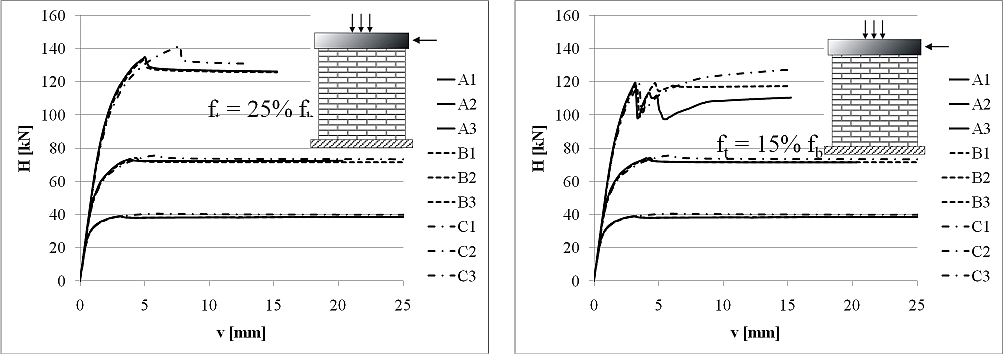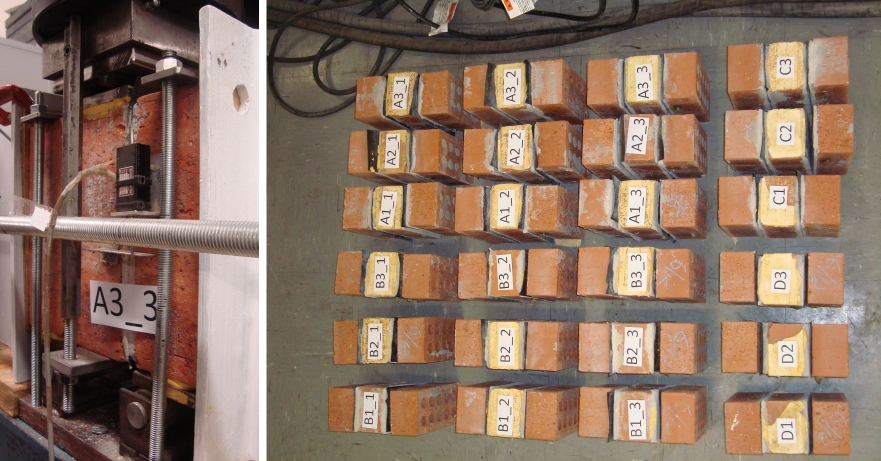Masonry Walls with Damp-Proof Course Membrane Subjected to Cyclic Shear
A joint research project by University of Newcastle and ETH Zurich on the structural behaviour of unreinforced masonry elements subjected to cyclic shear is underway at the University of Newcastle, Australia. The main goal of the research project is to investigate the influence of a damp-proof course (DPC) on the structural behaviour of masonry walls subjected to shear when the DPC is placed in a bed joint or at the interface of the masonry and its supporting concrete slab.
Within the framework of the project a series of static-cyclic shear tests on brick masonry wallettes were performed at the University of Newcastle. Cyclic load tests were performed on two series of masonry elements with a DPC placed into one of the bed joints. Each series consisted of nine 110 mm thick clay brick masonry wallettes with nominal dimensions of 1200x1200 mm. The DPC was placed either between the first two courses (Series A) or between the concrete base and first masonry course (Series B). In addition, three control specimens with the same dimensions and without a DPC were tested (Series C). The specimens were at first subjected to a vertical pre-compression load, which was kept constant during the test and then subjected to a cyclic shear load applied in time steps with prescribed horizontal displacements. Three different levels of pre-compression were considered. For each level of pre-compression, three replicates were tested for Series A and B, resulting in a total of 21 tests being performed.
This research project is supported by Centre for Infrastructure Performance and Reliability (CIPAR) of the University of Newcastle, Think Brick Australia and Department of Civil, Environmental and Geomatic Engineering of ETH Zurich. Their support is gratefully acknowledged.
This work is presented in following publications:
N. Mojsilovic, G. Simundic and A.W. Page: "DownloadStatic-Cyclic Shear Tests on Masonry Wallettes with a Damp-Proof Course Membrane (PDF, 5 MB)vertical_align_bottom", ETH Zurich, Institute of Structural Engineering, IBK Report 319, November 2009.
Mojsilovic N., G. Simundic and A.W. Page: "external pageMasonry wallettes with damp-proof course membrane subjected to cyclic shear: An experimental studycall_made", Construction and Building Materials 24(11), 2010, pp. 2135-2144.
N. Mojsilovic, G. Simundic and A.W. Page: "Load Tests on Masonry Wallettes subjected to cyclic shear", Proceedings, 8th International Masonry Conference, The International Masonry Society, Dresden, July 4-7, 2010, V. 11, pp. 487-496.
In the second phase of the research project a numerical study of the in-plane lateral load resistance and behaviour of unreinforced masonry shear walls with damp proof course has been performed. The results of the numerical modelling using a simplified micro-modelling approach showed its efficiency for detailed modelling as well as for the assessment of the lateral resistance of structural elements where a good correlation with the experimental results have been obtained.
This work is presented in:
N. Mojsilovic, V. Bosiljkov, A.W. Page and G. Simundic: "Assessment of unreinforced brick masonry shear walls with DPC using an experimental and numerical approach ", Proceedings, 9th Australasian Masonry Conference, Queenstown, February 15-18, 2011.
As an extension of the above-mentioned project, additional static-cyclic tests were performed on masonry triplets with incorporated DPC membrane. The specimens consisted of three bricks and two bed joints with the DPC being placed in the middle of the bed joints (Series A) or between the bed joints and the brick unit (Series B) and have been tested in acordance with the European Testing Standard EN 1052-3. For the test series typical Australian extruded clay bricks and embossed polythene DPC membrane have been used. Each series consisted of 9 specimens and a standard cement-lime mortar was used to produce 10 mm thick bed joints. After preparation and prescribed curing time the elements were firstly subjected to a given pre-compression and subsequently subjected to the cyclic shear load which was applied using computer controlled displacement steps. Each step was repeated twice in the form of a sinusoidal wave. Three different levels of pre-compression were considered (0.2 MPa, 0.6 MPa and 1.0 MPa) and for each level and for each specimen of both series three replicates were tested. In addition, two Series, C and D (each consisted of three specimens), which corresponded to the above mentioned Series A and B, respectively, were tested under static loading.
This part of the research project is supported by the International Co-operation Program of the Swiss National Science Foundation (SNF), Centre for Infrastructure Performance and Reliability (CIPAR) of the University of Newcastle and Think Brick Australia. Their support is gratefully acknowledged.
This work and its findings are presented in the following publication:
N. Mojsilovic, G. Simundic and A.W. Page: "DownloadStatic-Cyclic Shear Tests on Masonry Triplets with a Damp-Proof Course Membrane (PDF, 537 KB)vertical_align_bottom", 12th Canadian Masonry Symposium, Vancouver, June 2-5, 2013, Paper No. 159.
This project has been completed.



